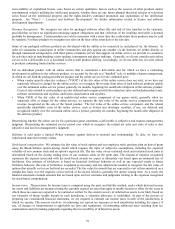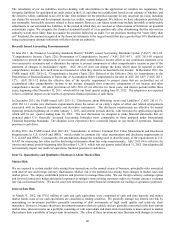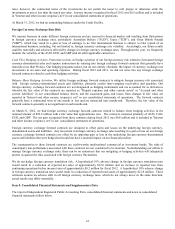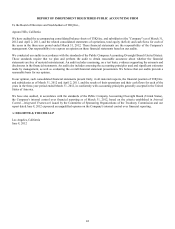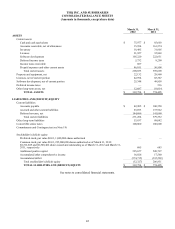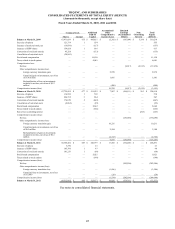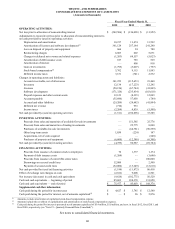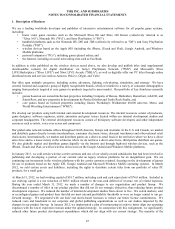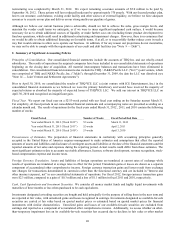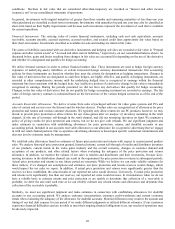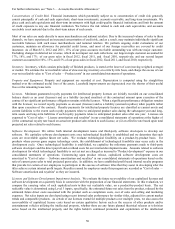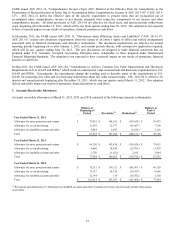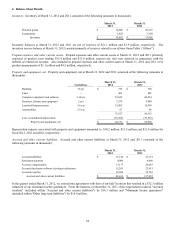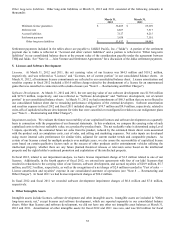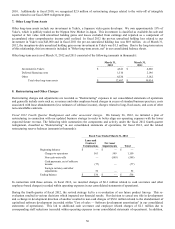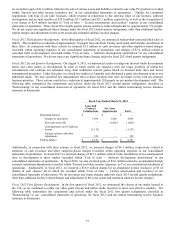THQ 2012 Annual Report Download - page 57
Download and view the complete annual report
Please find page 57 of the 2012 THQ annual report below. You can navigate through the pages in the report by either clicking on the pages listed below, or by using the keyword search tool below to find specific information within the annual report.49
conditions. Declines in fair value that are considered other-than-temporary are recorded as "Interest and other income
(expense), net" in our consolidated statements of operations.
In general, investments with original maturities of greater than three months and remaining maturities of less than one year
when purchased are classified as short-term investments. Investments with maturities beyond one year may also be classified as
short-term based on their highly liquid nature and because such investments represent the investment of cash that is available
for current operations.
Financial Instruments. The carrying value of certain financial instruments, including cash and cash equivalents, accounts
receivable, accounts payable, accrued expenses, accrued royalties, and secured credit lines approximate fair value based on
their short-term nature. Investments classified as available-for-sale and trading are stated at fair value.
The assets or liabilities associated with our derivative instruments and hedging activities are recorded at fair value in "Prepaid
expense and other current assets" or "Accrued and other current liabilities," respectively, on our consolidated balance sheets. As
discussed below, gains and losses resulting from changes in fair value are accounted for depending on the use of the derivative
and whether it is designated and qualifies for hedge accounting.
We utilize forward contracts in order to reduce financial market risks. These instruments are used to hedge foreign currency
exposures of underlying assets, liabilities, or certain forecasted foreign currency denominated transactions. Our accounting
policies for these instruments are based on whether they meet the criteria for designation as hedging transactions. Changes in
fair value of derivatives that are designated as cash flow hedges, are highly effective, and qualify as hedging instruments, are
recorded in other comprehensive income until the underlying hedged item is recognized in earnings within the financial
statement line item consistent with the hedged item. Any ineffective portion of a derivative change in fair value is immediately
recognized in earnings. During the periods presented we did not have any derivatives that qualify for hedge accounting.
Changes in the fair value of derivatives that do not qualify for hedge accounting treatment are recorded in earnings. The fair
value of foreign currency contracts is estimated based on the forward rate of the various hedged currencies as of the end of the
period.
Accounts Receivable Allowances. We derive revenue from sales of packaged software for video game systems and PCs and
sales of content and services over the Internet and for wireless devices. Product sales are recognized net of allowances for price
protection and returns and various customer discounts. We typically only allow returns for our PC products; however, we may
decide to provide price protection or allow returns for our video games after we analyze: (i) inventory remaining in the retail
channel, (ii) the rate of inventory sell-through in the retail channel, and (iii) our remaining inventory on hand. We maintain a
policy of giving credits for price protection and returns, but we do not give cash refunds. We use significant judgment and
make estimates in connection with establishing allowances for price protection, returns, and doubtful accounts in any
accounting period. Included in our accounts receivable allowances is our allowance for co-operative advertising that we engage
in with our retail channel partners. Our co-operative advertising allowance is based upon specific contractual commitments and
does not involve estimates made by management.
We establish sales allowances based on estimates of future price protection and returns with respect to current period product
sales. We analyze historical price protection granted, historical returns, current sell-through of retailer and distributor inventory
of our products, current trends in the video game industry and the overall economy, changes in customer demand and
acceptance of our products, and other related factors when evaluating the adequacy of the price protection and returns
allowance. In addition, we monitor the volume of our sales to retailers and distributors and their inventories, because slow-
moving inventory in the distribution channel can result in the requirement for price protection or returns in subsequent periods.
Actual price protection and returns in any future period are uncertain. While we believe we can make reliable estimates for
these matters, if we changed our assumptions and estimates, our price protection and returns reserves would change, which
would impact the net sales we report. In addition, if actual price protection and returns were significantly greater than the
reserves we have established, the actual results of our reported net sales would decrease. Conversely, if actual price protection
and returns were significantly less than our reserves, our reported net sales would increase. In circumstances when we do not
have a reliable basis to estimate returns and price protection or are unable to determine that collection of a receivable is
probable, we defer the sale until such time as we can reliably estimate any related returns and allowances and determine that
collection of the receivable is probable.
Similarly, we must use significant judgment and make estimates in connection with establishing allowances for doubtful
accounts in any accounting period. We analyze customer concentrations, customer credit-worthiness and current economic
trends when evaluating the adequacy of the allowance for doubtful accounts. Material differences may result in the amount and
timing of our bad debt expense for any period if we made different judgments or utilized different estimates. If our customers
experience financial difficulties and are not able to meet their ongoing financial obligations to us, our results of operations may
be adversely impacted.


